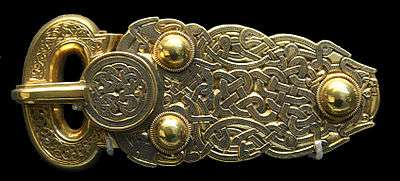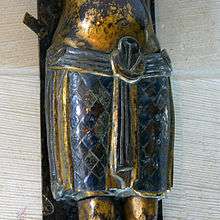Niello



Niello is a black mixture of copper, silver, and lead sulphides, used as an inlay on engraved or etched metal. The Egyptians are credited with originating niello decoration, which spread throughout Europe during the late Iron Age[1] and is common in Anglo-Saxon, Celtic and other types of Early Medieval jewellery.
Renaissance niello
The goldsmiths of Florence in the middle of the 15th century ornamented their works by means of engraving the metal with a burin, after which they filled up the hollows produced by the burin with a black enamel-like compound made of silver, lead and sulphur. The resulting design, called a niello, was of much higher contrast and thus much more visible.
Kievan Rus
During the 10th to 13th century AD, Kievan Rus craftsmen possessed a high degree of skill in jewelry making. John Tsetses, a 12th-century Byzantine writer, praised the work of Kievan Rus artisans and likened their work to the creations of Daedalus, the highly skilled craftsman of Greek mythology.
Niello was used on a variety of objects including sword hilts, chalices, plates, horns, adornment for horses, and most prolifically, jewelry for women: necklaces, bracelets, rings, torques, pendants, buttons, belt buckles, headdresses, etc.
The Kievan Rus technique for niello application was first shaping silver or gold by repoussé work, embossing, and casting. They would raise objects in high relief and fill the background with niello using a mixture of red copper, lead, silver, potash, borax, sulphur which was liquefied and poured into concave surfaces before being fired in a furnace. The heat of the furnace would blacken the niello and make the other ornamentation stand out more vividly.
Nielloed items were mass-produced using molds that still survive today and were traded with Greeks, the Byzantine Empire, and other peoples that traded along the trade route from the Varangians to the Greeks.
During the Mongol invasion from 1237 to 1240 AD, nearly all of Kievan Rus was overrun. Settlements and workshops were burned and razed and most of the craftsmen and artisans were killed. Afterwards, skill in niello and cloisonné enamel diminished greatly.
The Ukrainian Museum of Historic Treasures, located in Kiev, has a large collection of nielloed items mostly recovered from tombs found throughout Ukraine.[2]
Thai jewelry
Nielloware jewelry and related items from Thailand were popular gifts from American soldiers taking "R&R" in Thailand to their girlfriends/wives back home from the 1930s to the 1970s. Most of it was completely handmade jewelry.
The technique is as follows: The artisan would carve a particular character or pattern into the silver, leaving the figure raised by carving out the "background". He would then use the niello inlay to fill in the "background". After being baked in an open fire, the alloy would harden. It would then be sanded smooth and buffed. Finally, a silver artisan would add minute details by hand. Filigree was often used for additional ornamentation. Nielloware is classified as only being black and silver colored. Other colored jewelry originating during this time uses a different technique and is not considered niello.
Many of the characters shown in nielloware are characters originally found in the Hindu legend Ramayana. The Thai version is called Ramakien. Important Thai cultural symbols were also frequently used. Collecting Thai jewelry (correctly known as Siam Silver jewelry) is a growing hobby with many jewelry enthusiasts.[3]
See also
| Wikimedia Commons has media related to Niello. |
References
- ↑ Solberg, S., with reference. (2003) Jernalderen I Norge, page 158. Oslo, Norway: J.W. Cappelens Forlag,
- ↑ Ganina, O. (1974) The Kiev museum of historic treasures. (A. Bilenko, Trans.). Kiev, Ukraine: Mistetstvo Publishers.
- ↑ Archived July 8, 2011, at the Wayback Machine.
Further reading
- Ganina, O. (1974), The Kiev museum of historic treasures (A. Bilenko, Trans.). Kiev, Ukraine: Mistetstvo Publishers.
- Dittell, C. (2012), Overview of Siam Sterling Nielloware, Tampa, FL
- Dittell, C. (2012), Survey of Siam Sterling Nielloware, (E-Book), Bookbaby Publishers
- Untracht, Oppi Metal techniques For Craftsmen, New York 1968.
External links
- The Siam Sterling Nielloware Site
- Nielloware in Thailand Niello information site.
- E.Brepohls article on niello work